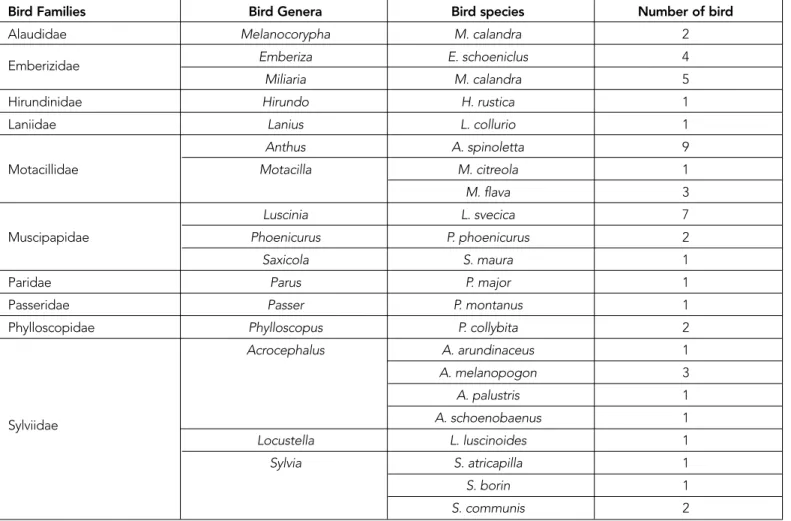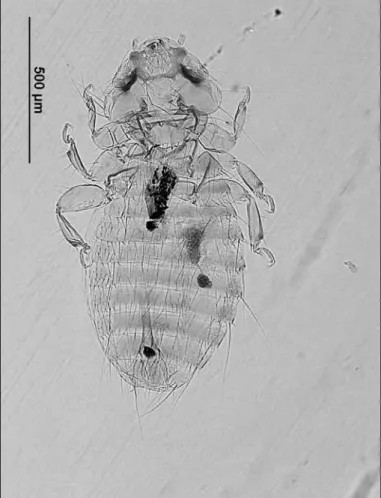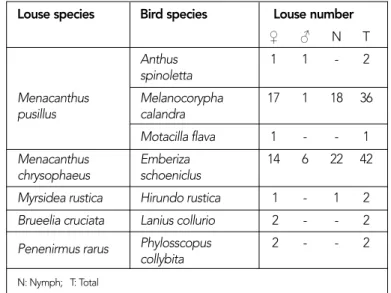Bilal Dik
1, Mehmet Ali Kirpik
2, Çağan Şekercioğlu
3, Yakup Şaşmaz
2 1University of Selçuk, Veterinary Faculty, Parazitoloji, Konya, Turkey2University of Kafkas, Faculty of Science and Arts, Deparment of Biology, Kars, Turkey 3Stanford University Center for Conservation Biology, Department of Biology, Stanford, ABD
ABSTRACT
Objective: This study was performed to detect chewing lice species found on the songbirds at Lake Kuyucuk bird ringing station in the Kars province located in eastern Turkey.
Methods: Chewing lice were collected from songbirds captured between September and October 2009. Fifty-one birds belonging to 22 species and 16 genera from 10 families were examined for the louse.
Results: Eleven of 51 birds (21.57%) belonging to 7 species; were infested with at least one chewing louse species. The collected lice were identified as Menacanthus chrysophaeus (Kellogg, 1896) on Reed Bunting, Menacanthus pusillus (Nitzsch,1866) on Water Pipits, Calandra Lark and Yellow Wagtail, Myrsidea rustica (Giebel,1874) on Swallow, Brueelia cruciata (Burmeister,1838) on Red-backed Shrike, and Pen-enirmus rarus (Zlotorzycka,1976) on Chiffchaff. All four Reed Bunting specimens were infested with Menacanthus chrysophaeus. The rate of infestation was 100% in Reed Bunting, Red-backed Shrike and Swallow; 66.7% in Yellow Wagtail; 50% in Calandra Lark and Chiffchaff and 11.1% in Water Pipits. No louse infestation was found in the birds belonging to Paridae, Passeridae, Sylviidae, and Muscipapidae families. Conclusion: Menacanthus chrysophaeus on Reed Bunting and Menacanthus pusillus on Calandra Lark are new hosts for these lice species. All the louse species determined in the present study are fi rst records for Turkey. (Turkiye Parazitol Derg 2011; 35: 34-9)
Key Words: Phtiraptera, chewing lice, Amblycera, Ischnocera, Turkey Received: 26.08.2010 Accepted: 01.12.2010
ÖZET
Amaç: Bu çalışma Türkiye’nin Doğu Anadolu bölgesinde, Kars ili Kuyucuk Gölü Kuş Halkalama İstasyonu’nda yakalanan ötücü kuşlardaki bit türlerini belirlemek amacıyla yapıldı.
Yöntemler: Ötücü kuşlardaki çiğneyici bit örnekleri Eylül-Ekim 2009 tarihleri arasında toplandı. Bu amaçla 10 aile, 16 cins ve 22 türe ait 51 kuş bit yönünden incelendi.
Bulgular: İncelenen 51 kuştan yedi türe ait 11 tanesinin (%21.57) en azından bir bit türü ile enfeste olduğu tespit edildi. Bataklık Kirazkuşu
(Em-beriza schoeniclus)‘dan Menacanthus chrysophaeus (Kellogg, 1896), Dağ İncirkuşu (Anthusspinoletta), Sarı Kuyruksallayan (Motacilla flava) ve Boğmaklı Toygar (Melanocorypha calandra)’dan Menacanthus pusillus (Nitzsch, 1866), Kırlangıç (Hirundo rustica)’dan Myrsidea rustica (Giebel, 1874), Kızılsırtlı Örümcekkuşu (Lanius collurio)’dan Brueelia cruciata (Burmeister, 1838) ve Çıvgın (Phylloscopus collybita)’dan Penenirmus rarus (Zlotorzycka, 1976) olmak üzere beş tür saptandı. Bataklık Kirazkuşlarının hepsi Menacanthus chrysophaeus ile enfeste bulundu. Enfestasyon oranı, Bataklık Kirazkuşu, Kızılsırtlı Örümcekkuşu ve Kırlangıç’ta %100, Sarı Kuyruksallayan’da %66,7, Boğmaklı Toygar ve Çıvgın’nda %50, Dağ İncirkuşu’nda ise %11,1 olarak tespit edildi.
Sonuç: Menacanthus pusillus’a Boğmaklı Toygar’da, M. chrysophaeus’a ise Bataklık Kirazkuşu’nda ilk kez rastlanmış olup, her iki konak da bu türler için ilk kayıttır. Bu çalışmada tespit edilen bit türlerinin tamamı Türkiye faunası için yeni kayıtlardır. (Turkiye Parazitol Derg 2011; 35: 34-9) Anahtar Sözcükler: Phtiraptera, çiğneyici bit, Amblycera, Ischnocera, Türkiye
Geliş Tarihi: 26.08.2010 Kabul Tarihi: 01.12.2010
This paper was presented as a poster presentation in the Fourth International Conference of Phthiraptera in June 13-18th in 2010, Ürgüp, Turkey Address for Correspondence/Yazışma Adresi: Dr. Bilal Dik, University of Selçuk, Veterinary Faculty, Parazitoloji, Konya, Turkey Phone: +90 332 223 27 36 Fax: +90 332 241 00 63 E-mail: bdik@selcuk.edu.tr
doi:10.5152/tpd.2011.09
Chewing Lice (Phthiraptera) Found on Songbirds (Passeriformes) in Turkey
Chewing lice (Phthiraptera: Amblycera, Ishnocera) are perma-nent obligate ectoparasites and are distributed worldwide throughout most bird families (1). The order Phthiraptera has nearly 5000 species in some 28 families (2), most of which have been reported from birds (1). Chewing lice living on feathers, such as ischnocerans, although causing damage to feathers, affect their hosts much less than do amblycerans (1).
In Turkey, 465 bird species are known (3), but the current knowl-edge on the louse fauna of birds in Turkey is quite incomplete. There is no comprehensive document about louse infestation on passeriform birds in Turkey. However, the availability of Brueelia
nebulosa, Myrsidea cucullaris and Sturnidoecus sturni have been
reported on starlings (4). The objective of this study was to inves-tigate and identify louse species on passeriform birds in Turkey.
MATERIAL AND METHODS
Field work was carried out between September and October 2009 at Lake Kuyucuk Bird Ringing Station in Kars, eastern Turkey (43o27’ N, 40o45’ E). The Kuyucuk Lake Wildlife Reserve is one of
the most important wetlands of eastern Turkey, where it is the only Ramsar wetland. It is also a “Key Biodiversity Area (KBA) and globally Important Bird Area (IBA)’, located 37 kms north-east of Kars city centre, and 15 kms west of Akyaka town. Kuyucuk Lake is over 219 hectares and has an elevation of 1.627
sheep and cattle. Kuyucuk Lake is the most important wetland in Kars for the birds. It hosts at least 214 bird species, some glob-ally Endangered (White-headed Duck, Egyptian Vulture, Red-breasted Geese), and large raptor and waterfowl populations, sometimes exceeding 40,000 birds at one time. Fifty-one song-birds belonging to 22 species and 16 genera from 10 families were caught in mist nets, and ringed in the area during the field studies. All the captured birds were examined for ectoparasites, particularly for louse infestation, and then released unharmed (Table 1). In order to collect the lice, the feathers of each bird were carefully rubbed over a white piece of paper with a syn-thetic pyrethroid insecticide harmless to vertebrates. Then the birds were placed in breathable paper bags for 5 minutes. All lice were collected and placed in tubes with 70% alcohol. The louse specimens were cleaned in 10% KOH, mounted in Canada balsam on slides, and identified to species under a light-micro-scope (5-8).
RESULTS
Eleven of 51 birds (21.57%) belonging to seven species were infested with at least one chewing louse species. Five louse spe-cies in four genera were identified: Menacanthus chrysophaeus (Kellogg, 1896) (Figure 1) on reed bunting (Emberiza
schoenic-lus), Menacanthus pusillus (Nitzsch, 1866) (Figure 2) on yellow
Bird Families Bird Genera Bird species Number of bird
Alaudidae Melanocorypha M. calandra 2
Emberizidae Emberiza E. schoeniclus 4
Miliaria M. calandra 5
Hirundinidae Hirundo H. rustica 1
Laniidae Lanius L. collurio 1
Anthus A. spinoletta 9
Motacillidae Motacilla M. citreola 1
M. flava 3
Luscinia L. svecica 7
Muscipapidae Phoenicurus P. phoenicurus 2
Saxicola S. maura 1
Paridae Parus P. major 1
Passeridae Passer P. montanus 1
Phylloscopidae Phylloscopus P. collybita 2
Acrocephalus A. arundinaceus 1 A. melanopogon 3 A. palustris 1 Sylviidae A. schoenobaenus 1 Locustella L. luscinoides 1 Sylvia S. atricapilla 1 S. borin 1 S. communis 2
wagtail (Motacilla flava), calandra lark (Melanocorypha calandra) and water pipits (Anthus spinoletta), Myrsidea rustica (Giebel, 1874) (Figure 3) on swallow (Hirundo rustica), Brueelia cruciata (Burmeister, 1838) (Figure 4) on red-backed shrike (Lanius
collu-rio), and Penenirmus rarus (Zlotorzycka, 1976) (Figure 5) on
chiff-chaff (Phylloscopus collybita). All specimens of reed bunting were infested with M. chrysophaeus (Table 3). The rate of infesta-tion was 100% in red-backed shrike and Swallow; 66.66% in yel-low wagtail; 50% in chiffchaff and 11.11% in water pipits (Table 2). No chewing lice were found on birds in Paridae, Passeridae, Sylviidae, and Muscipapidae families. Generally, the infested birds harboured a few lice. Minimum and maximum numbers of lice per infested bird were one and 33, respectively. All the louse species identified in the present study are the first records from Turkey. Menacanthus chrysophaeus on reed bunting and
Menacanthus pusillus on calandra lark are new hosts for these
lice species. All the louse species were identified in the present study are the first records for Turkey.
DISCUSSION
Lice comprise the only truly parasitic group amongst the exop-terygote insects. Lice exhibit a remarkable level of host specific-ity, unequalled in most other metazoan parasites. As permanent, obligate ectoparasites, the distributions of lice have mostly par-alleled those of their hosts (9). Consequently, lice are found on every continent and in most habitats occupied by birds and mammals. All orders and most families of birds have records of host-specific lice; of the few groups that do not, it is likely either that their lice are extinct or that the hosts have been searched insufficiently (9). Abiotic factors are known to influence the
geo-Figure 2. Menacanthus pusillus; a. female from Motacilla flava b. male from Anthus spinoletta, original
a
b
ous relationships of two ecosystem partners, parasites and their hosts, established through long co-evolutionary processes, should offer a better understanding of the dynamics of parasite communities on host animals, including humans (11). Parasitic lice have medical and veterinary importance, and their success-ful transmission is possible by direct physical contact and phore-sy between host individuals
Louse species such as Brueelia blagovescenskyi (Balat, 1955),
Philopterus residuus (Zlotorzycka, 1964), and Ricinus fringillae
(De Geer, 1778), were reported from reed bunting reed bunting (1), with P. residuus recently shown to be a new synonym of P.
citrinellae (Schrank, 1776) by Palma and Price (12). Although Philopterus citrinellae (P. residuus) was reported from two reed
buntings in the Northern Dobrogea of Romania (13), no
Philopterus sp. was observed on the examined reed bunting in
the present study. However, all examined reed buntings were observed to be infested with Menacanthus chrysophaeus (Kellogg, 1896) in the present study. Menacanthus spp. infesta-tions were investigated comprehensively on Passeriformes birds (5-8, 14). Until today, M. pusillus has been reported from 6
Anthus species, including A. spinoletta as well M. flava, M. alba
and Pyrrhula spp. (1). In the present study, one of the most com-mon chewing lice species was M. pusillus detected on yellow wagtail, whereas M. pusillus were collected from water pipits and corn bunting. On the other hand, there has been no
previ-Figure 5. Penenirmus rarus, female, original Figure 4. Brueelia cruciata, female, original
ous report of Menacanthus spp. infestation on reed buntings anywhere in the world. Many passerine louse species remain to be discovered in the developing world. For example, in Vietnam, 18 bird samples belonging to 6 genera out of 45 Passeriformes were found to be infested with chewing lice, and 7 louse species were identified on the examined birds. Six out of the 7 lice were found to be new species (15). According to some authors (5, 6), the genus Menacanthus has many species, is cosmopolitan, and its host specificity is very low. In parallel with the literature,
Menacanthus specimens were observed more frequently, and Menacanthus chrysophaeus from reed bunting and Menacanthus pusillus from calandra lark were recorded from these hosts for
the first time.
Similarly, tthe current knowledge of the louse fauna of birds in Turkey is quite incomplete. There is no comprehensive study on the louse infestation of Passeriformes birds in Turkey. However,
Brueelia sp., Brueelia nebulosa, Myrsidea cucullaris and Sturnidoecus sturni has been reported on starlings (4). On the
other hand, two house martins (Delichon urbica) and 13 sparrows (Passer domesticus) were examined for chewing lice, but no lice were found on any of the examined birds (16).
In the present study, eleven out of 51 birds (21.57%) belonging to 7 species were infested with at least one chewing louse spe-cies. The collected lice were identified as Menacanthus
chrysophaeus on reed bunting, Menacanthus pusillus (Nitzsch,
1866) on water pipits, calandra lark and yellow wagtail, Myrsidea
rustica (Giebel, 1874) on swallow, Brueelia cruciata (Burmeister,
1838) on red-backed shrike and Penenirmus rarus (Zlotorzycka, 1976) on chiffchaff. All reed bunting specimens were infested with Menacanthus chrysophaeus, whereas no chewing lice were found on the birds belonging to Paridae, Passeridae, Sylviidae and Muscipapidae families. However, it must be noted that no louse specimens have ever been collected from the moustached warbler, citrine wagtail and Siberian stonechat, which belong to these families (1) and on which we also found no lice.
In this study, more specimens of Amblycera were encountered. We found three species in two genera of Amblycera and two
Bird species Number of Number of
examined birds infested birds (%)
Reed Bunting 4 4 (Emberiza schoeniclus) (100) Corn Bunting 5 0 (Miliaria calandra) (0) Tree Sparrow 1 0 (Passer montanus) (0) Yellow Wagtail (Motacilla flava) 3 2 (66.66) Citrine Wagtail 1 0 (Motacilla citreola) (0) Water Pipits 9 1 (Anthus spinoletta) (11.11) Red-backed Shrike 1 1 (Lanius collurio) (100)
Great Tit (Parus major) 1 0
(0) Blackcap (Sylvia atricapilla) 1 0
(0) Garden Warbler (Sylvia borin) 1 0
(0) Whitethroat (Sylvia communis) 2 0
(0)
Great Reed Warbler 1 0
(Acrocephalus arrundinaceus) (0) Moustached Warbler 3 0 (Acrocephalus melanopogon) (0) Marsh Warbler 1 0 (Acrocephalus palustris) (0) Sedge Warbler 1 0 (Acrocephalus schoenobaenus) (0) Savi’s Warbler 1 0 (Locustella luscinoides) (0) Chiffchaff 2 1 (Phylloscopus collybita) (50) Redstart 2 0 (Phoenicurus phoenicurus) (0) Bluethroat (Luscinia svecica) 7 0
(0)
Siberian Stonechat 1 0
(Saxicola maura) (0)
Swallow (Hirundo rustica) 1 1
(100)
Calandra Lark 2 1
(Melanocorypha calandra) (50)
Total 51 11
(21.57)
Table 2. Studied bird species and infestation rates
Louse species Bird species Louse number
♀ ♂ N T Anthus 1 1 - 2 spinoletta Menacanthus Melanocorypha 17 1 18 36 pusillus calandra Motacilla flava 1 - - 1 Menacanthus Emberiza 14 6 22 42 chrysophaeus schoeniclus
Myrsidea rustica Hirundo rustica 1 - 1 2
Brueelia cruciata Lanius collurio 2 - - 2
Penenirmus rarus Phylosscopus 2 - - 2 collybita
N: Nymph; T: Total
wagtail. The examination of nine water pipits (A.spinoletta), seven bluethroat (L.svecica) and five corn bunting (M.calandra) resulted in the discovery of only two lice specimens on one A.
spinoletta. On the other hand, all four reed bunting (E. schoeni-clus) and two out of three yellow wagtail (M.flava) we examined
were found to be infested with lice, and 42 and 36 louse speci-mens were collected from these species respectively. While wad-ers (Charadriiformes) that were examined at the same station during the same period were found to have higher infestation rates (88% of all individuals) and 668 louse specimens were col-lected from 41 individuals (17), it is interesting that the infesta-tion rate in passerines was four times lower (21.6%) and 87 were collected from 51 passerines. One likely reason for this is that the waders that were examined are larger than the passerines and hence, provide more living space for lice. The fact that waders are associated with water and tend to be more gregarious than the passerines examined may also have an influence, especially if the gregarious nature of the waders increases the likelihood of host-to-host transmission of lice. It is interesting to note that among the waders examined, the two species that had the high-est louse infhigh-estation (reed bunting and yellow wagtail) are also associated with wetlands and are more social than the other pas-serines examined.
In conclusion, in this study, Menacanthus chrysophaeus on reed bunting and Menacanthus pusillus on calandra lark were record-ed from these hosts for the first time. In addition, all the louse species that were identified are first records for Turkey. Because the current knowledge of the louse fauna of birds in Turkey is quite incomplete, it is highly possible that many new louse spe-cies will be discovered in future investigations. Phthiraptera comprise an important frontier of biodiversity research in Turkey.
Acknowledgments
We thank the Kuzey Doğa Society (www.kuzeydoga.org), Kuyucuk Bird Research and Education Center volunteers, Kuyucuk ringing station manager Sedat İnak, Emrah Çoban, and Önder Cırık for their help. We are grateful for the support of the Christensen Fund, the Conservation Leadership Programme, the Whitley Fund, and the Kafkas University Research Fund. We thank the Kars Directorate of Environment and Forestry and Turkey Directorate of Nature Conservation and National Parks (DKMPGM) for providing the research permits.
REFERENCES
1. Price RD, Hellenthal RA, Palma RL, Johnson KP, Clayton DH. The Chewing Lice: World checklist and biological overview. Illinois Natural History Survey Special Publication, 24. x + 501 pp. 2003. 2. Cranston PS, Gullan PJ. Phylogeny of insects. In: Resh VH & Cardé
RT (eds.) Encyclopedia of Insects. 2nd ed. Elsevier, San Diego. 2009; pp. 780-93.
3. Sekercioglu CH. A birder’s guide to Turkey. Living Bird 2006; 26: 14-23. 4. Dik B, Uslu U, Derinbay Ekici Ö, Işık N. Türkiye’de, sığırcıklarda
(Sturnus vulgaris, L.) görülen bit (Phthiraptera; Ischnocera Amblycera) türleri. Türkiye Parazitol Derg 2009; 33: 316-20.
5. Palma RL, Price RD, Hellenthal RA. New synonymies and host records for lice of the genus Menacanthus (Phthiraptera: Menoponidae) from the Passeriformes (Aves). J Royal Society of New Zealand 1998; 28: 309-20. [CrossRef]
6. Price RD. The Menacanthus (Mallophaga: Menoponidae) of the Passeriformes (Aves). J Med Entomol 1977; 14: 207-20.
7. Zlotorzycka J. Mallophaga parasitizing Passeriformes and Pici IV.Menacanthinae, Ricinidae, Degeeriellinae. Acta Parasitol Pol 1965;13: 41-69.
8. Zlotorzycka J. Wszoly-Mallophaga. Nadrodzina Menoponoidea. Polskie Towarzystwo Entomologiczne [Klucze do Oznaczania Owadów Polski] 1976; 15: 2: 1-189.
9. Smith VS. Phthiraptera (Chewing and Sucking Lice). pp. 249-258. In Grzimek’s Animal Life Encyclopedia: Insects (ed. Michael Hutchins). Thomson Gale. Farmington Hills 2003.
10. Bush SE, Harbison CW, Slager DL, Peterson AT, Price RD, Clayton DH. Geographic variation in the community structure of lice on western scrub-jays. J Parasitol 2009; 95: 10-3. [CrossRef]
11. Kim I, Lee EM, Seol KY, Yun EY, Lee YB, Hwang JS, et al. The mitochondrial genome of the Korean hairstreak, Coreanaraphaelis, (Lepidoptera: Lycaenidae). Insect Mol Biol 2006; 15: 217-25. [CrossRef]
12. Palma RL, Price R. Lice of the genus Philopterus Nitzsch (Phthiraptera: Ischnocera: Philopteridae) parasitic on host of the genus Emberiza (Passeriformes: Emberizidae). New Zealand Journal of Zoology 2006; 33: 1-6. [CrossRef]
13. Rékási J, Kiss JB. New data on the lice (Phthiraptera) of some birds in Northern Dobrogea (Romania). Acrocephalus 2006; 27: 139-45. 14. Zlotorzycka J. Europäische Arten der Mallophagen-Gattung
Pleurinirmus. Angew Parasitol 1976; 17: 208-14.
15. Sychra O, Literák I, Hung NM, Podzemny P. Chewing lice from passerines (Aves, Passeriformes) from Vietnam, with description of a new species of the genus Brueelia (Phthiraptera, Ischnocera, Philopteridae). Acta Parasitol 2009; 54: 154-7. [CrossRef]
16. Dik B. Türkiye’deki Evcil ve Yabani Kanatlılarda Bulunan Çiğneyici Bit (Phthiraptera) Türleri. Türkiye Parazitol Derg 2010; 34: 55–60. 17. Dik B, Sekercioğlu CH, Kirpik MA, Inak S, Uslu U. Chewing Lice
(Phthiraptera) Species found on Turkish Shorebirds (Charadriiformes). Kafkas Univ Vet Fak Derg, 16 (5): 867-874, 2010



